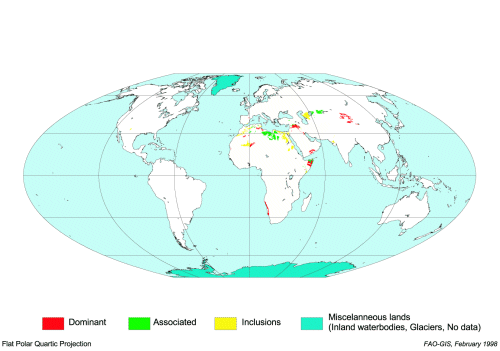
Gypsisols
Encyclopedia

Fão
Fão is a town in Esposende Municipality in Portugal....
World Reference Base for Soil Resources
World Reference Base for Soil Resources
The World Reference Base for Soil Resources is the international standard taxonomic soil classification system endorsed by the International Union of Soil Sciences . It was developed by an international collaboration coordinated by the International Soil Reference and Information Centre and...
are soils with substantial secondary accumulation of gypsum
Gypsum
Gypsum is a very soft sulfate mineral composed of calcium sulfate dihydrate, with the chemical formula CaSO4·2H2O. It is found in alabaster, a decorative stone used in Ancient Egypt. It is the second softest mineral on the Mohs Hardness Scale...
(CaSO4.2H2O). They are found in the driest parts of the arid
Arid
A region is said to be arid when it is characterized by a severe lack of available water, to the extent of hindering or even preventing the growth and development of plant and animal life...
climate
Climate
Climate encompasses the statistics of temperature, humidity, atmospheric pressure, wind, rainfall, atmospheric particle count and other meteorological elemental measurements in a given region over long periods...
zone.In the USDA soil taxonomy
USDA soil taxonomy
USDA Soil Taxonomy developed by United States Department of Agriculture and the National Cooperative Soil Survey provides an elaborate classification of soil types according to several parameters and in several levels: Order, Suborder, Great Group, Subgroup, Family, and Series.- Example of...
they are classified as Gypsids (USDA Soil Taxonomy), in the Russian soil classification they are called Desert soils (USSR).
Gypsisols are developed in mostly unconsolidated alluvial, colluvial
Colluvium
Colluvium is the name for loose bodies of sediment that have been deposited or built up at the bottom of a low-grade slope or against a barrier on that slope, transported by gravity. The deposits that collect at the foot of a steep slope or cliff are also known by the same name. Colluvium often...
and aeolian deposits of base
Base (chemistry)
For the term in genetics, see base A base in chemistry is a substance that can accept hydrogen ions or more generally, donate electron pairs. A soluble base is referred to as an alkali if it contains and releases hydroxide ions quantitatively...
-rich weathering
Weathering
Weathering is the breaking down of rocks, soils and minerals as well as artificial materials through contact with the Earth's atmosphere, biota and waters...
material. They are found on level to hilly land in arid regions. The natural vegetation is sparse and dominated by xerophytic shrubs and trees and/or ephemeral grasses
These soils have ABC profiles. Accumulation of calcium sulphate, with or without carbonates, is concentrated in and below the B-horizon
Horizon
The horizon is the apparent line that separates earth from sky, the line that divides all visible directions into two categories: those that intersect the Earth's surface, and those that do not. At many locations, the true horizon is obscured by trees, buildings, mountains, etc., and the resulting...
.
Deep Gypsisols located close to water
Water
Water is a chemical substance with the chemical formula H2O. A water molecule contains one oxygen and two hydrogen atoms connected by covalent bonds. Water is a liquid at ambient conditions, but it often co-exists on Earth with its solid state, ice, and gaseous state . Water also exists in a...
resources can be planted to a wide range of crops. Yields are severely depressed where a petrogypsic horizon occurs at shallow depth. Nutrient imbalance, stoniness, and uneven subsidence of the land surface upon dissolution of gypsum in percolating (irrigation
Irrigation
Irrigation may be defined as the science of artificial application of water to the land or soil. It is used to assist in the growing of agricultural crops, maintenance of landscapes, and revegetation of disturbed soils in dry areas and during periods of inadequate rainfall...
) water are further limitations. Irrigation canals must be lined to prevent the canal walls from caving in. Large areas of Gypsisols are in use for low volume grazing
Grazing
Grazing generally describes a type of feeding, in which a herbivore feeds on plants , and also on other multicellular autotrophs...
.
Gypsisols are exclusive to arid regions; their worldwide extent is probably of the order of 100 million hectares. Major occurrences are in and around Mesopotamia in desert areas in the Middle East
Middle East
The Middle East is a region that encompasses Western Asia and Northern Africa. It is often used as a synonym for Near East, in opposition to Far East...
and adjacent central Asian republics
Central Asia
Central Asia is a core region of the Asian continent from the Caspian Sea in the west, China in the east, Afghanistan in the south, and Russia in the north...
, in the Libya
Libya
Libya is an African country in the Maghreb region of North Africa bordered by the Mediterranean Sea to the north, Egypt to the east, Sudan to the southeast, Chad and Niger to the south, and Algeria and Tunisia to the west....
n and Namib
Namibia
Namibia, officially the Republic of Namibia , is a country in southern Africa whose western border is the Atlantic Ocean. It shares land borders with Angola and Zambia to the north, Botswana to the east and South Africa to the south and east. It gained independence from South Africa on 21 March...
deserts, in southeast and central Australia
Australia
Australia , officially the Commonwealth of Australia, is a country in the Southern Hemisphere comprising the mainland of the Australian continent, the island of Tasmania, and numerous smaller islands in the Indian and Pacific Oceans. It is the world's sixth-largest country by total area...
and in the southwestern USA.

